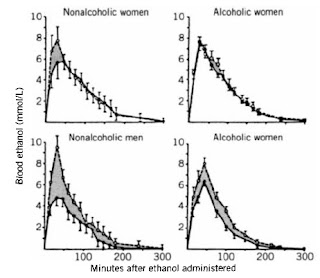ALCOHOLIC BEVERAGES AND HUMAN RESPONSES
Alcoholic beverages are, in essence, flavored solutions of ethanol. The flavors may come from grains, as in beer; or from grapes and other fruit, as in wine; or from any source of carbohydrates, grains, sugar, or grapes, as in whiskey, rum, and brandy. In addition, consumers may add their own flavors, as lime with some beers or fruits with some wine or carbonated sodas with distilled spirits.
The spectrum of flavors is wide indeed. But the purpose of drinking any of these is to supply ethanol in measured doses to the user. Ethanol is as unique as humanity itself. It is a food but requires no digestion. It acts on many organs in the body but has no cellular receptors as do all other drugs. It is stable in the atmosphere to any chemical change, whereas all other foods will undergo some kind of decomposition. It is the only food produced solely by microbial action. It enters any cell in the body, freely, without any transport mechanism.
All other foods (and all other substances except water) require a transport mechanism to enter any cell. It provides energy more rapidly than any other food. This article inquires more closely into these and other aspects of ethanol. Although alcohol is a generic term for a large group of related substances, so common is ethanol that the term alcohol has been usurped for it and will be used here from now on to mean ethanol. So common is the drinking of alcoholic beverages that the word drink or drinker implies the drinking of alcoholic beverages and not any others.
People have always needed a release from reality. From earliest recorded history this release has come quite effectively from alcohol. It must have been discovered by accident, and probably in more than one place. It is readily produced from any saccharous source, is pleasant tasting, and not prone to any pathogenic divergence. Whether alcohol appeared first from grapes as wine or from grain as beer or from honey as mead is not known. The catalyst that converts any of these into alcohol is ubiquitous. A recipe for beer has been found on a clay tablet from Mesopotamia some 4000 yr old.
In the Far East it was probably beer. In early cultures the making of alcohol was so cherished that it fell under the domain of the priest and clergy. Vestiges of this still remain in many monasteries in Europe.
GENERAL METABOLISM OF ALCOHOL
 |
| The first step in the metabolism of alcohol is a dehydrogenation to acetaldehyde. |
This is mediated by the enzyme alcohol dehydrogenase, with nicotine adenine dinucleotide (NAD+ ) as hydrogen acceptor. The reaction is reversible, and the reverse reaction is the last step in the process by which alcohol is produced by yeast. This reaction is followed by the oxidation of the aldehyde to acetate, brought about by another enzyme, aldehyde dehydrogenase, again with NAD+ .
This reaction has never been reversed. The acetate in turn joins with coenzyme A to form the ever-present acetyl CoA. This can take part in the citric acid cycle and be oxidized to CO2 and H2O. This scheme is shown in Figure 1. Alcohol dehydrogenase (ADH) exists in about 20 forms, each with differing activity toward ethanol and to other alcohols. These isozymes vary in concentration among diverse ethnic groups, no doubt accounting for different sensitivities to alcohol by different peoples.
All forms have zinc as the core metallic element. ADH is found in all tissues, including red and white blood cells and the brain. Before 1970, it was thought that ADH existed only in the liver, but that is certainly not the case. That it is present in many isosteric forms is probably rooted in the many functions it performs and the many needs it satisfies in metabolism. Aldehyde dehydrogenase (ALDH) also exists widely in humans.
Cytoplasmic ALDH is the same in all people, whereas the mitochondrial ALDH does differ among people, with that found in Asians being less active than the form found in whites. But it is probable that mitochondrial ALDH is not nearly as important in oxidizing acetaldehyde as is cytoplasmic ALDH. Because very little acetaldehyde is found circulating in the blood even after high alcohol intake, it is assumed that the rate-limiting step in alcohol metabolism is the first step—its dehydrogenation to acetaldehyde.
HOW ALCOHOL IS CONSUMED
 |
| Wine The fermentation of the juice of grapes produces a wine containing about 12% alcohol by volume (10% by weight). |
The stoichiometry of fermentation, dictates that a 22°Brix grape juice will give an alcohol solution of somewhat more than 10% by weight. Perhaps by evolutionary coincidence, a 10% alcohol solution is close to the limit that most yeasts can produce. Because most countries forbid the addition of water to grape juice before fermentation, wines worldwide are very similar in alcohol content. Champagnes, which are fermented twice, may be a little higher, say 14% by volume. Fortified wines, such as port and sherry, are wines to which brandy has been added at some stage. These may contain as much as 20% alcohol by volume.
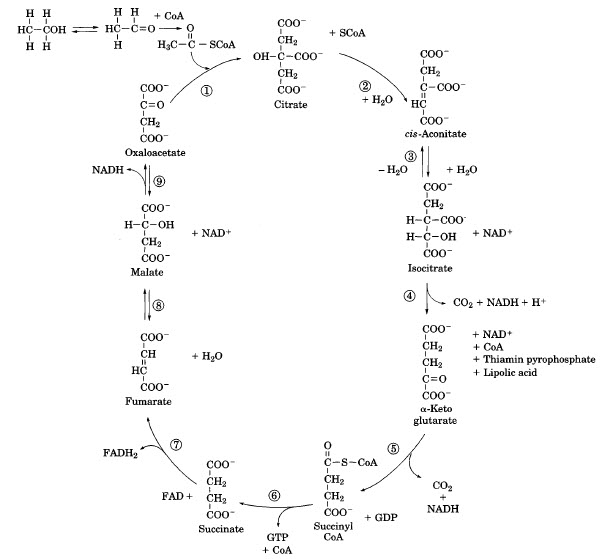 |
| Figure 1. The citric acid cycle |
Other fruits may also be fermented to wine, but only apple juice, as cider, has found even limited acceptance.
Beer
The solution from which beer is made, called wort, is made at the brewery and not in nature. As such, its concentration and fermentability (see BEER) are designed for the beer being made and may vary widely. But the concentration of the wort only varies between 12 and 18°Brix, and the fermentability between about 60% and 90%. So beer is never as high in alcohol as wine. Typically, beer contains 5% alcohol by volume (4% by weight). So-called malt liquors contain about 6% alcohol by volume.
Mead
As honey is about 82% solids, it must be diluted to about 20°Brix and then fermented. The high price of honey and the rather weak flavor of its fermented solution has not permitted mead to be more than a historical curiosity.
Distilled Spirits
These spirits are distilled at a rather high proof, be they from grains (whiskey or vodka), molasses (rum), or wine (brandy), and are diluted to a marketable strength. The normal concentration is about 80 proof or 40% by volume or 32% by weight. Whiskeys are usually consumed after mixing with water, often carbonated, and also flavored. As purchased, wine is 2 stronger than beer, and whiskey is 3 or more times stronger than wine.
ABSORPTION OF ALCOHOL
Alcohol is absorbed into the bloodstream mainly from the upper small intestine. Although it enters the stomach, there is only a limited exit into the blood from that organ. Emptying of the stomach's contents is controlled by the pyloric sphincter muscle at the base of the stomach. It opens when the pH of the contents falls below 3. The presence of proteins, which act as buffers, or fats, which delay access of the stomach's enzymes and acid to their substrates, delay the fall in pH and thus also the exit of food or drink from the stomach. All the blood that nourishes the entire digestive tract, and that in turn carries all the digested foodstuffs from the tract, first enters the liver via the portal vein. Thus alcohol absorbed from the stomach or the small intestine goes first to the liver.
This probably accounts for the old and incorrect belief that alcohol is oxidized to acetaldehyde only in the liver. Alcohol consumed at high concentrations is absorbed more rapidly than when consumed in diluted forms. The presence of carbon dioxide also accelerates the absorption. Fatigue and exercise delay the absorption. It has been recently found that a considerable amount of alcohol is metabolized in the stomach to acetaldehyde, and that the quantity oxidized is higher in men than in women and lower in alcoholic men and women.
The blood alcohol curves for alcohol administered by mouth or intravenously for nonalcoholic and alcoholic men and women are shown in Figure 2. Of course, the alcohol metabolized in the stomach can have no effect elsewhere. This so-called first-pass metabolism accounts for the more ready effect that alcohol has on women than on men. A comparison among whiskey, wine, and beer showing the maximum blood alcohol concentrations for the three beverages is shown in Table 1.
Wine and whiskey reach about the same maximum concentration, but whiskey is faster. Beer achieves a lower maximum, and it takes longer to get there. At a lower alcohol level, the same relative relations are maintained, but the maximum concentrations attained are lower (Fig. 3). Table 2 shows the relationship between body weight, amount of beer and whiskey to reach certain blood alcohol levels, and the time at which the maximum concentration is reached.
For example, an average person weighing 175 Ib (79.5 kg) who consumes four 12-oz bottles of beer will have a maximum blood alcohol level of 0.08% in about 95 min. Another set of experiments compared the sequential blood alcohol levels in a group of 50 men weighing between 145 and 175 Ib who consumed 44 g of alcohol (four bottles of beer or four shots of whiskey) at once. The results in Figure 4 show that while whiskey produces a maximum blood alcohol level of 0.085, beer only gives a maximum of 0.045. Fig. 5 shows the maximum blood alcohol concentration, in percent of various alcoholic beverages. The effect of dilution on whiskey action is very marked.
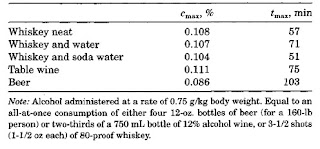 |
| Table 1. Effects of Alcoholic Beverages on the Maximum Blood Alcohol Levels and the Time at Which These Levels Are Reached |
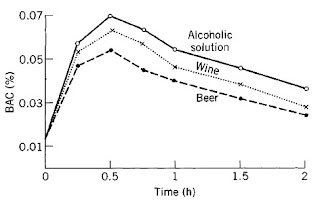 |
| Figure 3. Blood alcohol curve after ingestion of 0.5 g alcohol per kg body weight in form of a diluted alcoholic solution (12.5%), of wine (11%), and of beer (5.5%) (mean value of 13 subjects). |
 |
| Table 2. |
PHYSIOLOGICAL ACTIONS OF ALCOHOL
Alcohol is one of only two substances to which human cells have never found a need to bar entrance. The only other freely moving substance is water. Because there is no barrier to entrance, there are no known cellular receptors to alcohol. This free movement indicates that the body does not consider alcohol toxic or in any way foreign.
It is this facile movement that permits alcohol to be excreted in the urine and in breath and also permits it to be found and measured in the breath. There is many-faceted evidence that alcohol is a product of normal metabolism in humans; it has even been found in teetotalers. The amount is low, about 0.001%.
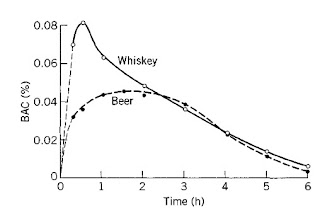 |
| Figure 4. Blood alcohol curve after ingestion of 44 g alcohol in form of whiskey and of beer by 50 subjects, weighing between 65 and 79 kg. |
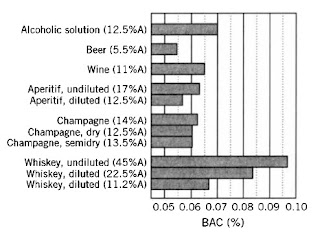 |
| Figure 5. Blood alcohol maximum after ingestion of 0.5 g alcohol per kg body weight in form of several alcoholic beverages with different dilutions. |
Effect of Alcohol on Fluid Balance
The initial effect of alcohol is to produce a slight retention of water, followed by a more marked diuresis of water and sodium. This latter effect is due to an inhibition by alcohol of the pituitary antidiuretic hormone (vasopressin). This diuresis occurs only when the concentration of blood alcohol content is rising. The concerted drinking of wine or whiskey, but not beer, requires the imbibition of other fluids to maintain homeostasis.
Effect of Alcohol on Nutrition Alcohol is readily metabolized and yields 6.9 kcal/g. The rate of metabolism varies from person to person and ranges from 50 to 100 mg/kg of body weight per hour. Alcohol does not affect the use of dietary protein and is as effective as carbohydrates in protecting the body from loss of protein. Alcohol does not raise heat production or CO2 production, so it has no thermogenic effect.
There is no increase in alcohol metabolism with exercise, nor a decrease with rest. Alcohol has only a minor effect on appetite. Distilled spirits consumed in concentrated form decrease gastric motility, whereas dilute alcohol increases gastric motion. These will appear to affect appetite. In addition, during a meal, the palate-cleansing action of wine and beer will promote eating and lessen the feeling of satiety.
It is probably the tannin in wine and the hops in beer that are responsible for this action. Yet heavy drinkers are far less likely to be obese than nondrinkers. Among a large group of low-income women in their 30s, 41% of nondrinkers were obese, whereas only 22% of heavy drinkers were so rated. Among men, the ratio is 31% obese for nondrinkers and 16% for drinkers.
Effects of Alcohol on the Central Nervous System
The primary effect of alcohol in the body is a sequential depressant action on the central nervous system. From the spinal cord rises the medulla oblongata, the pons, and the midbrain, the control centers for the autonomic nervous system, which regulates reflexes and those functions beyond control of the will. Above the midbrain lies the thalamus and hypothalamus, whose dominion includes functions not willfully regulated, such as body temperature, metabolism of fats, and blood sugar level. Above all this, and more recent in the evolution of the species, lie the cerebellum and the cerebral cortex.
The former has sway over voluntary muscular movements and manual skills, as well as balance and speech. The cerebral cortex, the corolla of the mind, is master of all that distinguishes humans and makes them distinguished. Alcohol, which has ready access to all cells and crosses the almost impenetrable blood-brain barrier as if it were a sieve, exerts its earliest action on the cerebral cortex. Its action is not as a stimulant but as a tranquilizer or depressant.
It lessens inhibitions and increases confidence. It replaces discontent with discovery, bashfulness with bravado, and cowardice with courage. Alcohol negates a no and affirms a yes. These effects, which people had sought long before the tensions of modern life were imposed on them, occur at blood levels between 0.02 and 0.05%. Whatever pressures and problems were mankind's lot in Biblical days, they were surely different in scope and pervasiveness than those we confront today.
But alcohol was used then and was considered of priestly stature. In many cultures, its production was limited to the clergy. Apparently, the evolution of the cerebral cortex, with its awesome powers of the mind, brings with it a need to lessen its potent sway over our actions. This alcohol does with speed and thoroughness. At blood alcohol levels between 0.05 and 0.10%, the sphere of its influence expands to the cerebellum. Balance and speech become less than normal.
The gait becomes unsteady and speech uncertain. It is at the higher of these levels that ability to operate machinery is impaired. At 0.2%, balance is more seriously affected and speech nearly incoherent. Neurotransmission in the cerebellum is disturbed. At increasing blood alcohol concentrations, the effects become deeper and parts of the brain developed earlier in evolution are also effected. At 0.3-0.4%, most of the behavior that we call human is sharply curtailed if not lost.
Anesthesia sets in. In fact, alcohol was the earliest anesthetic, before ether was discovered. At 0.5-0.6% a remarkable shut-off valve operates and wakefulness is not maintained. This normally prevents any further action, because even the autonomic nervous system, controlling basic functions of respiration and heart beat, are denervated at a level above 0.6% and death ensues. But sleep normally prevents further inhibition, so fatal levels are not attained except with rapid drinking of strong whiskey. Fatal levels cannot be achieved with wine or beer.
Interaction of Alcohol and Other Nutrients
Alcohol and its primary metabolite, acetate, serve as excellent sources of energy. Alcohol and acetate penetrate the blood-brain barrier almost as efficiently as glucose. Everywhere, alcohol is used in preference to all other energy sources. Acetyl CoA, the entry point of all energy sources into the citric acid cycle, is most easily produced from alcohol. Also, while all other energy sources—fatty acids, glucose, and amino acids—can be stored in polymolecular forms, alcohol and acetate cannot be stored. Neither do they act as substrates for conversion to glucose, amino acids, or lipids. Alcohol must thus be metabolized as it becomes available.
Effect on the Digestive Tract
Alcohol slightly increases gastric and intestinal mobility. It also has a slight positive but very transient effect on ' appetite. It has no effect on the absorption of fats or cholesterol from the intestinal tract. Some of the very slight appetite stimulation may not even be due to alcohol, but to other factors present in some alcoholic beverages— juniper in gin, bitters in some aperitifs, hops in beer.
Effect on Cardiovascular System
Alcohol slightly dilates peripheral capillaries, leading to blushing and a feeling of warmth. The effects are transitory and meager. Moderate alcohol consumption reduces the risk of coronary heart disease. It also reduces the risk of cardiac mortality. Its action is probably mainly due to its effect on raising the HDL levels in the blood, as well as lowering the triglyceride levels. Physical activity has the same effect, and the effects are additive.
Moderate drinking is taken to be between 25 and 80 g of alcohol a day (two to six 12-oz. bottles of beer, 5% alcohol by volume; 250-750 ml of table wine [12% alcohol]; or 70- 250 ml of whiskey [80 proof]). The LDL in the blood (the "bad" cholesterol) is now believed to have its malign effect on atherosclerosis after it is oxidized. And so antioxidants have been shown to have a protective effect. This is the so-called French Paradox: the French consume diets high in cholesterol and saturated fats and yet have very low coronary artery disease.
The explanation is their relatively high consumption of alcohol, mainly in the form of red wine. Many of the polyphenals, gallic acid, rutin, epicatechin, and quercitin present in red wine are potent antioxidants. Such phenolics are also present in oak-aged whiskey and in full-bodied and darker beers. Alcoholic beverages therefore have a two-pronged effect on reducing coronary heart disease, raising the "good" HDL and keeping the LDL from becoming "bad."
Effect of Alcohol on Men versus Women
Alcohol per se has the same effects on either sex. However, a given amount of alcohol has a greater effect on women than on men for several reasons. First, women are usually smaller than men, so a given volume of an alcoholic beverage will have a greater effect on the smaller person. Second, women have a lower water content in their bodies than do men. Thus the alcohol, which is only soluble in water and not in fat, will reach a higher concentration in women. This difference in water content, on an equal weight basis, is about 12%. And last, and probably most important, women have a lower gastric activity of alcohol dehydrogenase than do men.
They therefore do not destroy as much alcohol in their stomach as do men, allowing more of it to be absorbed into the blood. This phenomenon, only recently discovered, is known as first-pass metabolism. It may differ by 20- 30% between men and women. Thus the bioavailability of alcohol is considerably greater in women than in men. However, men over 50 years of age begin to lose the high alcohol dehydrogenase activity in their stomachs and become equal to women in their first-pass metabolism.
Alcohol as Medicine
Before the advent of the modern pharmacopoeia, alcohol was prescribed for many human ills. It dulls pain, summons sleep, soothes the spirit, and tames the teeming mind. Each of these functions can now be accomplished by a coterie of drugs, so alcohol is rarely recommended for these ills. But no one substance does all of what alcohol does, and people in all cultures have found alcohol to be the preferred, and possibly less noxious, means to tranquility.
Furthermore, as a controlled way to peace and pleasure, alcohol has no peer. Regulations in the United States prohibit any declaration of therapeutic value for any alcoholic beverage, so each generation must rediscover the value of alcohol. Many countries permit some therapeutic claim for alcohol, such as a bedtime relaxer or tension reducer. As medicine, alcohol differs from drugs. All drugs are detoxified in the liver, ie, the liver so chemically modifies the drug as to render it inactive and able to be excreted, usually by the kidneys. This detoxification usually involves oxidation, hydrolysis, or sulfation. But alcohol is not detoxified, it is metabolized, just as is any foodstuff. No drug supplies energy; alcohol does. It may be more valid to consider alcohol as a food that has effects on the body rather than as a drug.
As was pointed out earlier, alcohol has free entrance to every cell in the body; no drug has. All drugs operate by attaching themselves to a specific cellular receptor; alcohol needs none and has none. Alcohol has at least one clinically proven and prescribed medicinal function. It is the only antidote to poisoning with ethylene glycol (antifreeze). Quick administration of alcohol, usually intravenously, makes all alcohol dehydrogenase sites act on the alcohol, harmlessly, instead of acting on the glycol, which produces very toxic oxalic acid. The glycol, not oxidized, is slowly excreted by the kidneys. The preferential reaction of alcohol dehydrogenase with alcohol permits this therapeutic action. There are foods other than alcohol that affect the brain and human behavior. The amino acid tryptophane is a soporific and has been used as such.
Meals high in carbohydrates produce high tryptophane blood levels. This they do by producing an influx of insulin into the blood, which in turn mobilizes some amino acids from plasma to muscle, leaving a higher concentration of tryptophane in the plasma. Histidine, threonine, tyrosine, and choline also are neuroactive, but their action is compromised by complex factors. There are no confirmed allergies to alcohol per se. Its free entrance to all cells and ubiquitous presence mitigate against any allergic reaction.
Alcohol the Day After
The day after a serious session of drinking is often one of mental and physical fatigue and headache. In the United States, these symptoms are lumped together and called a hangover. In other languages the term is more descriptive, a wooden mouth in French, for example. The symptoms relate to the known constituents of alcoholic beverages and the known physiology of alcohol.
Alcohol masks fatigue, so a night of drinking will lead to excessive activity, which will be revealed by fatigue and malaise the next day. Rest always allows return to the normal state. The dry mouth or excessive thirst is the result of the diuretic effect of alcohol (and possibly the very salty nibbles that often accompany drinking). Drinking water or fruit juice, and a little time, alleviate this condition. The headache may result from the fatigue and the dehydration but may also result from the congeners of distilled spirits and of wine. The congeners are simple compounds produced by yeast concomitant with alcohol.
They range from ethyl acetate to amyl alcohol. Also, particularly in some wines, and in brandy, there may be measurable amounts of methyl alcohol. These levels of methyl alcohol are not toxic per se, but when metabolized to formaldehyde may produce headaches. The drinking of a small amount of some alcoholic beverage the next day, possibly beer or vodka, will induce the liver to return to oxidizing alcohol and allow the methanol to be eliminated by the kidneys.
Alcohol and Alcoholism
Alcohol, although it effects many organs and systems, is singularly responsible for only one disease, alcoholism. Those who have this disease are called alcoholics. An alcoholic has been denned as a person who has a compulsion to drink and cannot stop drinking once begun, to the point where that person's social and economic life are adversely affected. There is no certain cause of this disease, although a genetic factor may well be involved. An alcoholic is a heavy drinker, but not all heavy drinkers are alcoholics. Drinking because they want to characterizes drinkers, heavy or light, but drinking because they have to is the hallmark of alcoholics.
In an alcoholic drinking sets up a chain reaction, which terminates only with sleep. There is no clear evidence that an alcoholic metabolizes alcohol any differently than others, but there appears to be, in alcoholics, a strong predilection toward alcohol metabolism, rather than carbohydrate or fat metabolism, as the major energy source. Alcoholism may lead to several other pathological conditions. It is important to understand that alcoholics may derive up to or even above 50% of their daily caloric requirements in the form of alcohol. The human system can only tolerate such univalent load with carbohydrates. Either fat or protein in such excess will lead to problems of a different nature, but none the less severe. The major problem facing alcoholics is a series of metabolic and structural changes in the liver.
The initial change is the accumulation of fats in the liver, resulting in a fatty liver. This is easily reversible. It occurs because, in the presence of alcohol, the liver uses it as a preferential source of energy and the fatty acids, which it would otherwise use, accumulate. This change is followed, after some years, by structural changes in the liver, including scarring or necrosis of the liver tissue, the mark of cirrhosis. About 20% of long-term alcoholics develop cirrhosis. Alcohol consumption equivalent to about 50% of the daily caloric intake, for from 5 to 20 yr, is necessary to induce cirrhosis in susceptible persons. Cessation of drinking often leads to reversal of the cirrhotic condition.
The male to female ratio of alcoholics in the United States is now 4:1. Although alcohol is a necessary component in alcoholism, it is no more correct to say that alcohol is the cause of alcoholism than it would be to say that marriage is the cause of divorce. The roots of alcoholism are social, metabolic, and genetic. No medical treatment exists. The use of drugs that produce unpleasant symptoms if alcohol is consumed is not widespread because of toxic effects. Societal treatment, in groups of peers such as Alcoholics Anonymous, has proved most beneficial. Prenatal alcohol abuse can lead to birth defects known as fetal alcohol syndrome.
The most benign symptom is low birth weight, and the most serious is impaired brain development and mental retardation. The most severe effects are known to occur in chronic alcoholics, but because it is neither known what the safe lower limit of alcohol intake is nor when during the pregnancy alcohol is most likely to harm the fetus, it is generally recommended to avoid alcohol during pregnancy.
The Salubrity of Alcohol
The vast majority of consumers of alcohol—as beer, wine, or distilled spirits—do so because it makes them feel better. It relieves stress and smooths the way from work to winding down. Not for naught has the time in a tavern after work and before the trip home come to be called the happy hour. In addition to general relief from stress and care, moderate drinkers have been found to show genuine improvement in health. Recall that the ill effects of alcohol are confined to those who consume, regularly and for many years, alcohol in excess of 80 g a day.
This amounts to almost two cases (twenty-four 12 oz packages) of beer a week, or more than a 750 mL bottle of wine a day, or six 1-1/2 oz shots of whiskey a day. The consumption of moderate amounts of alcohol has been found to decrease stepwise the risk of coronary heart disease. The lowest level of consumption produces the least salutary effect, and the highest levels, more than 31 g but less than 80 g a day, reduce the risk to only 20-75% of that in nondrinkers. These results have been found in many studies, in many lands, among men and women, and among various socioeconomic strata. The Framingham Study, the longest and largest research of its kind, has always found this correlation between alcohol consumption and coronary heart disease—moderate alcohol use lowers the risk of coronary heart disease.
The recent (1989) Physicians Health Study, in which 22,000 physicians were studied prospectively, to determine the effect of aspirin on cardiovascular mortality showed incidentally that daily alcohol consumption significantly reduced the overall mortality rate over that produced by aspirin alone. Physicians using alcohol daily and taking aspirin had a myocardial infarction rate of 1% whereas those taking aspirin alone had a 1.4% rate. This 40% improvement was among the best of any other risk factor studied. The synergistic effect of moderate alcohol consumption was not expected.
Alcohol and Drugs
Alcohol has a potentiating effect on some drugs, particularly sedatives. This may be drug specific, but also in many cases is due to the fact that the liver, where all drugs are detoxified, may prefer to metabolize alcohol and the drugs may persist in the bloodstream longer than they would normally. Repeating the drug dosage, in, say, 4 or 6 h, may lead to an overdosage if the drug has not been removed by the liver. Those taking drugs for any chronic ailments should find out if alcohol interferes with the action or metabolism of those drugs.


